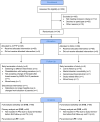Complex, low-intensity, individualised naturalistic developmental behavioural intervention in toddlers and pre-schoolers with autism spectrum disorder: The multicentre, observer-blind, parallel-group randomised-controlled A-FFIP trial
- PMID: 40135359
- PMCID: PMC12447682
- DOI: 10.1111/jcpp.14162
Complex, low-intensity, individualised naturalistic developmental behavioural intervention in toddlers and pre-schoolers with autism spectrum disorder: The multicentre, observer-blind, parallel-group randomised-controlled A-FFIP trial
Abstract
Background: Naturalistic developmental behavioural interventions (NDBI) may improve social communication in toddlers/pre-school aged children with autism spectrum disorder (ASD). Here, we study efficacy of the low-intensity, complex NDBI 'Frankfurt Early Intervention Program for ASD' (A-FFIP) over 1 year by a confirmatory phase-III, prospective, randomised, controlled, parallel-group study with two treatment arms over four centres.
Methods: Main inclusion criteria: ASD (DSM-5), age 24-66 months, developmental quotient >30.
Intervention: Manualised A-FFIP intervention. Control intervention: Early intervention as usual (EIAU).
Primary outcome: Change in core ASD symptoms from baseline (T2) to immediate intervention endpoint at 12 months (T6) based on the blindly rated Brief Observation for Communication Change (BOSCC) total score.
Statistical analysis: Mixed model for repeated measures with covariates baseline BOSCC-total, chronological age and centre.
Results: Between July 2018 and October 2021, N = 134 children with ASD were randomly allocated to intervention (A-FFIP: n = 68, EIAU: n = 66). Groups did not differ at baseline, with a mean age of 49 (SD 10) months, a mean developmental age of 23.3 (SD 13.6) months and 26 (19.4%) females. The SARS-CoV-2 pandemic interfered severely with trial procedures. Intention-to-treat analysis in the primary analysis set, with at least one postbaseline BOSCC measure (A-FFIP n = 64, EIAU n = 60), did not find differences in the primary outcome by group (adjusted ES -0.06, 95% CI to -0.24 to 0.11). SARS-CoV2-related lockdown led to less improvement across groups. Secondary outcomes showed stronger improvements in parent-rated repetitive behaviour as well as parent- and teacher-rated executive functions for A-FFIP versus EIAU. Adverse events were comparable between groups.
Conclusions: The manualised NDBI program A-FFIP, which allows individually targeting six core basic abilities and five developmental domains related to longitudinal development in ASD, did not improve social communication, cognitive or behavioural outcomes beyond EIAU after 1 year, but may improve repetitive behaviour and executive function.
Keywords: Naturalistic; autism; behavioural; developmental; randomised‐controlled; repetitive behaviour; social communication.
© 2025 The Author(s). Journal of Child Psychology and Psychiatry published by John Wiley & Sons Ltd on behalf of Association for Child and Adolescent Mental Health.
Conflict of interest statement
CMF and KT receive royalties for the A‐FFIP intervention manual. CMF, JG, TJ, JK, MN, VR and KT receive royalties for additional books on ASD, ADHD or MDD. CMF, JG, JK, MN, LP, VR, KT and RT received allowances for lectures on ASD and other mental health issues from public and private health care institutions. CMF has received consultation honoraria from the company IGES on a study evaluating staff regulations for standard mental health care in Germany (2024) and from the Institute for Quality and Efficiency in Health Care (Institut für Qualität und Wirtschaftlichkeit im Gesundheitswesen, IQWiG) for a brochure on parent and patient information on ASD (2023). VR carried out clinical trials in cooperation with Servier and Shire Pharmaceuticals/Takeda companies. The remaining authors have declared that they have no competing or potential conflicts of interest.
Figures



References
-
- Bednarz, H.M. , Trapani, J.A. , & Kana, R.K. (2020). Metacognition and behavioral regulation predict distinct aspects of social functioning in autism spectrum disorder. Child Neuropsychology, 26, 953–981. - PubMed
-
- Bölte, S. , Rühl, D. , Schmötzer, G. , & Poustka, F. (2008). ADI‐R: Diagnostisches Interview für Autismus – Revidiert: Deutsche Fassung des Autism Diagnostic Interview – Revised (ADI‐R). Bern: Huber.
-
- Bottema‐Beutel, K. (2016). Associations between joint attention and language in autism spectrum disorder and typical development: A systematic review and meta‐regression analysis. Autism Research, 9, 1021–1035. - PubMed
-
- Brown, H. , Swain, D. , Kim, H.W. , Rogers, S. , Estes, A. , Kasari, C. , … & Kim, S.H. (2025). Examining variability in Naturalistic Developmental Behavioral Intervention strategy use in caregivers of children with autism spectrum disorders. Journal of Child Psychology and Psychiatry, 66, 4–15. - PubMed
Publication types
MeSH terms
Grants and funding
LinkOut - more resources
Full Text Sources
Medical
Miscellaneous

